





BPQ01.jpg (taken 24.8.2008)
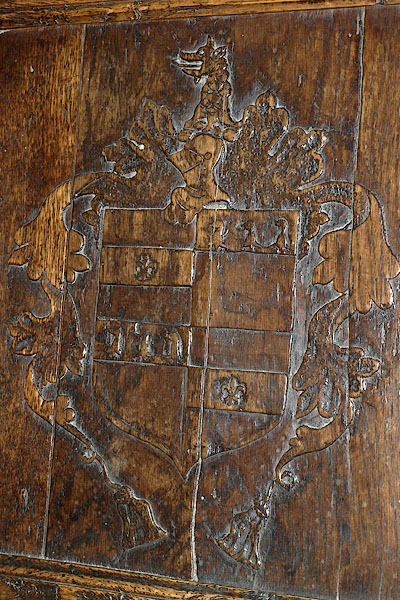
BRA65.jpg Coat of arms on Lord Derwentwater's Chair; ?wrongly said to have belonged to Sir John Radcliffe, Lord's Island, died 1529. The arms are NOT the Radcliffe Family arms.
(taken 24.8.2008) courtesy of Keswick Museum
placename:- Lords Island
 goto source
goto source"..."
"... in which [Derwent Water] there are three Islands, ... and the third has of late Years, had the Honour to be the Seat of the famous Family of Radcliffs, Knights, called from hence, for Distinction Sake, the Radcliffs of Derwentwater; the last of which Family was the late unhappy James, Earl of Derwentwater, who joining in a Rebellion against his Majesty King George I. was taken at the Battle of Preston in Lancashire, and beheaded on Tower Hill the 24th of February, 1716."
placename:- Lady Island
 goto source
goto sourceGentleman's Magazine 1751 p.52 "... one of these, called Lady Island, Ld Derwentwater had formerly a castle, now in ruins, intended to prevent the depredations which were frequently committed by the Scots before the union."
placename:- Lady Island
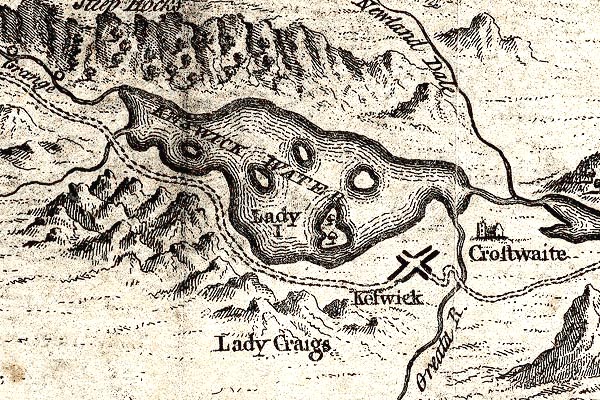
GM1311.jpg
"Lady I"
island
item:- JandMN : 114
Image © see bottom of page
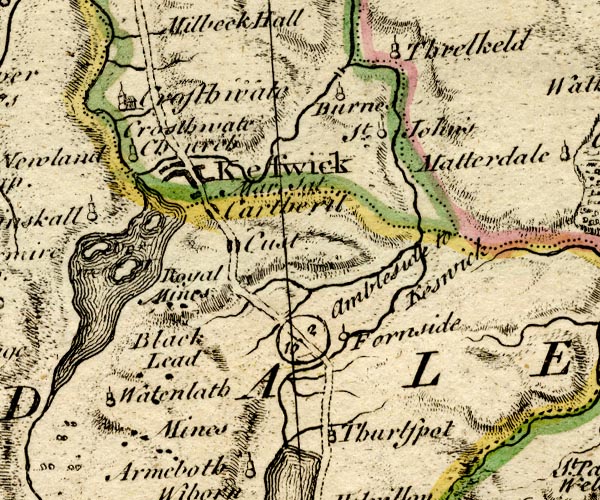
BO18NY21.jpg
in Derwent Water; the Royal Mines label belongs with the northerly island.
item:- Armitt Library : 2008.14.10
Image © see bottom of page
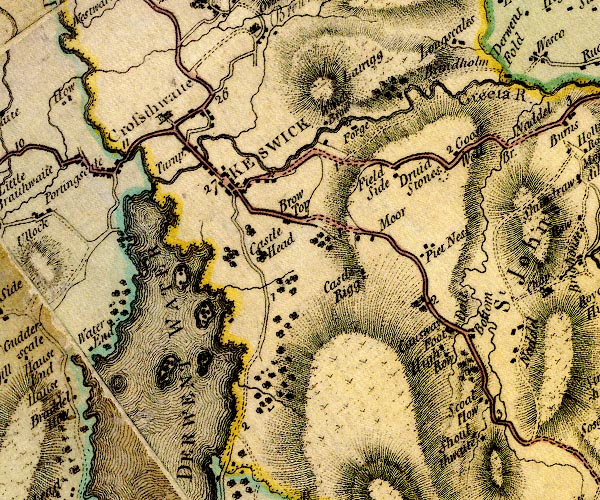
D4NY22SE.jpg
island in Derwent Water
item:- Carlisle Library : Map 2
Image © Carlisle Library
placename:- Lords Island
 goto source
goto sourcePage 90:- "[Derwent water] ... Lords-island, richly dressed in wood."
"..."
 goto source
goto sourcePage 115:- "[Mr Pennant's description] '... The isles that decorate this water are finely disposed, and very distinct, rise with gentle and regular curvatures above the surface, consist of verdant turf, or are planted with various trees. The principal is Lord's-island, above five acres, where the Ratcliff family had some time its residence, and, from this lake, took the title of Derwent-water. ...'"
placename:- Lord's Island
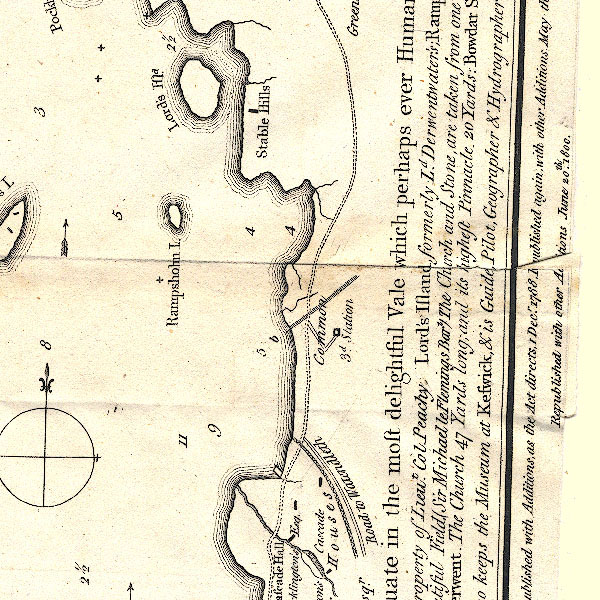
CT2NY21U.jpg
"Lord's Isld."
In the map title:- "Lord's Island, formerly Ld. Derwentwater's"
item:- Armitt Library : 1959.191.3
Image © see bottom of page
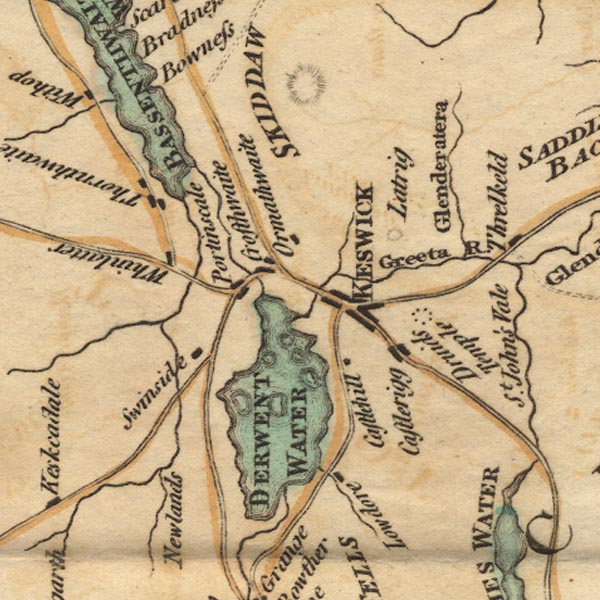
Ws02NY22.jpg
item:- Armitt Library : A1221.1
Image © see bottom of page
placename:- Lords Island
 goto source
goto source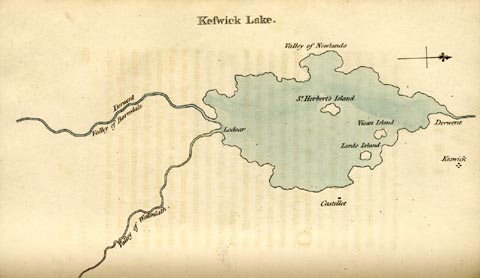 click to enlarge
click to enlargeGLP312.jpg
Plate vol 1 opposite p.179 in Observations on Picturesque Beauty published by T Cadell and W Davies, Strand, London, 1808.
caption from the list of plates:- "This plan of Keswick-lake means only to express the general shape of it; and the relative situation of it's several parts."
item:- Armitt Library : A918.12
Image © see bottom of page
placename:- Lords Island
 goto source
goto sourcevol.1 p.180 "The lake of Derwent, or Keswick-lake, as it is generally called, is contained within a circumference of about ten miles; presenting itself in a circular form, tho in fact it is rather oblong. It's area is interspersed with four or five islands; three of which only are of consequence, Lord's island, Vicar's island, and St. Herbert's island: but none of them is comparable to the island on Windermere, in point either of size, or beauty."
 goto source
goto sourcevol.1 p.181 "Lord's island has it's name from being the place, where once stood a pleasure-house, belonging to the unfortunate family of Derwent-water, which took it's title from this lake. The ancient manor-house stood on Castle-hill above Keswick; where the antiquarian traces also the vestiges of a Roman fort. But an heiress of Derwent-water marrying into the family of the Ratcliffs; the family-seat was removed from Keswick to Dilston in Northumberland."
 goto source
goto sourcevol.1 p.184 "..."
"To the formality of it's shores may be added the formality of it's islands. They are round, regular, and similar spots, as they appear from most points of view; formal in their situation, as well as in their shape; and of little advantage to the scene. ..."
placename:- Lord's Island
item:- Scots fir; mouse; cat
 goto source
goto sourcePage 70:- "..."
"Upon Lord's Island, the Radcliffs, Earls of Derwentwater, formerly had a seat, which, according to Nicholson and Burn, was built of stones that came from a castle founded by the Romans upon Castrigg, or Castle-Rigg. I do not believe the story, which I shall endeavour to prove when we pass it. There are some remains of the building upon the island to be seen, but the whole is now covered with wood."
"This once-flourishing family lost their estates in the year 1715, which were given by his Majesty King George I. to Greenwich Hospital. There is nothing upon this island worth landing for, except the refreshing shade upon a very hot day. It is planted with Scots firs, about twenty-seven years standing; amongst which there is room to walk, and seldom wants a fine cooling breeze. At the first planting of these trees, the island was so much infested with vermin, particularly mice, that they totally defeated all labours of the planters. So numerous and mischievous were these vermin, that after the trees had been planted three or four years, they were almost entirely destroyed by them: some, (particularly the firs,) were totally gnawed through a little above the ground; and others stripped of their bark, and thereby deprived of nutriment. Upon this, Mr Nicholson, who was Agent and Bailiff for Greenwich Hospital, collected several cats, whom he turned loose upon the island, and who soon overcame the mice. Afterwards some of the cats boldly swam to shore, and run wild amongst the woods; others perished with hunger, and some remained for several years."
placename:- Lord's Island
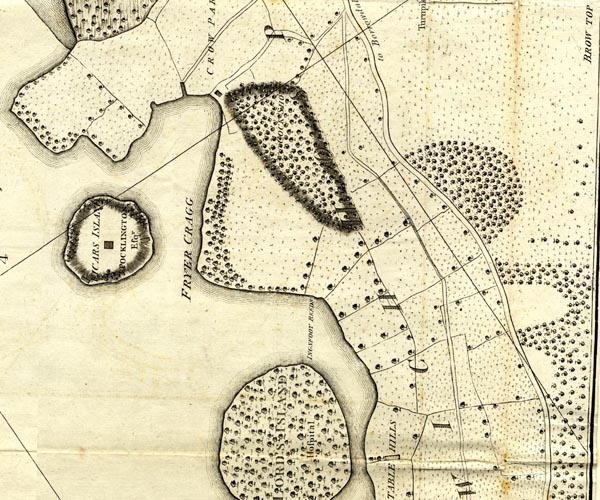
CL152622.jpg
"LORD'S ISLAND / Hospital"
wooded island
item:- private collection : 169
Image © see bottom of page
item:- 1715 Rebellion; Greenwich Hospital; oak; tree
 goto source
goto sourcePage 181:- "..."
"The Derwentwater family took their name from the place where they were seated from the reign of Edward I. Sir Nicholas Radcliffe of Dilston c. Northumberland, knt. married the heiress of the family in the reign of Henry VI. and his descendant Francis was created by James II. baron of Dilston, viscount Langley and Radcliff, and earl of Derwentwater; all which titles were forfeited with his estate and life by his son James, beheaded on Tower-hill 1716 for engaging in the rebellion. The estate amounted to £.20,000. a year, including the mines, was vested in trustees for the support of Greenwich hospital, but restored on the reversal of the attainder 177[ ]."
"..."
"... Castlerigg was the antient seat of the Derwentwater family, but after the marriage with the Radcliffs went to ruin, and with the materials the Radcliffs built a pleasure-house in one of the islands in Derwentwater. The large and stately oaks were felled by the trustees of Greenwich hospital, who lately replaced them by some small plantations. ..."
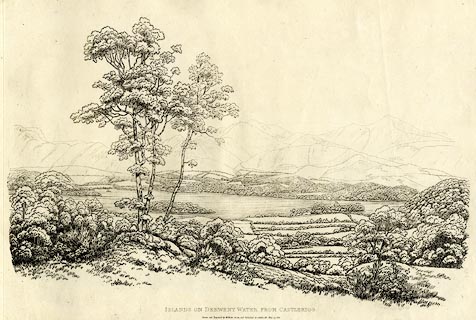 click to enlarge
click to enlargeGN1231.jpg
From near right to far - Derwent Isle, Lord's Island, St Herbert's Island?
Plate 31 in Sixty Studies from Nature, 1810.
printed at top right:- "31"
printed at bottom:- "ISLANDS ON DERWENT WATER FROM CASTLERIGG. / Drawn and Engraved by William Green, and Published at Ambleside, June 24, 1810."
watermark:- "J WHATMAN / 1813"
item:- Armitt Library : A6641.31
Image © see bottom of page
placename:- Lord's Island
item:- Armitt Library : A6666.15
Image © see bottom of page
placename:- Lord's Isle
 goto source
goto sourcePage 17:- "... Lord's Isle, contains about six acres and a half, and is covered with stately trees, forming a fine rookery. It is situated near the shore, on which account, probably, it was selected for the residence of the family of Derwentwater; but the house has long been in ruins, and nothing now remains but the foundation. This, and the smaller island called Rampsholm, form part of the late Earl of Derwentwater's sequestrated estate, which has been purchased from Greenwich Hospital in 1832, by John Marshall, Esq. of Leeds."
"..."
 goto source
goto sourcePage 118:- "... Lord's Island, near the shore, was once the residence of the family [of Derwentwater.]"
placename:- Lord's Island
 goto source
goto sourcePage 54:- "... Lord's Island, six acres in extent, once the residence of the unfortunate Radcliffes, is now entirely covered with wood: it is, along with Rampsholm, the property of W. Marshall, Esq. who purchased the Greenwich Hospital estates in this district. ..."
item:- aurora borealis; Lord Derwentwater's lights
 goto source
goto sourcePage 74:- "... The Ratcliffes also possessed Lord's Island, the largest on the lake, where their mansion is said to have been built, from the stones of the old one on Castlehead. ..."
 goto source
goto sourcePage 75:- "... Lord's Isle was once a part of the mainland. The Ratcliffes cut a fosse, in the feudal times, and set up a drawbridge. ... ... Every where are there traces of the unhappy family; even in the sky, where the aurora borealis is sometimes called, to this day, Lord Derwentwater's lights, because it was particularly brilliant the night after his execution."
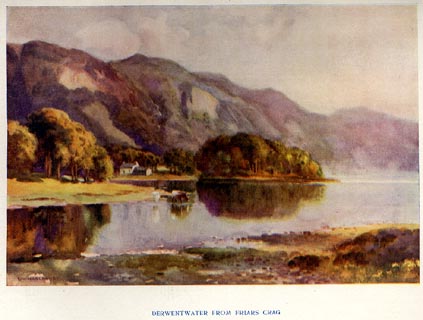 click to enlarge
click to enlargePR1567.jpg
Tipped in opposite p.40 of The English Lakes section of a volume of Our Beautiful Homeland.
printed at bottom:- "DERWENTWATER FROM FRIARS CRAG"
printed at lower left:- "E. W. HASLEHURST"
item:- JandMN : 381.9
Image © see bottom of page
placename:- Lord's Isle
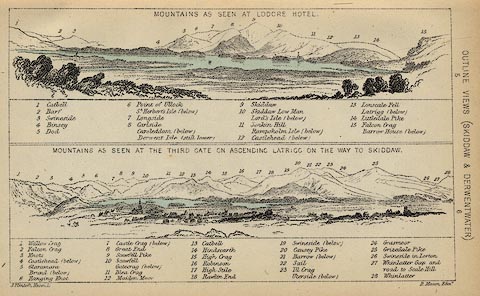 click to enlarge
click to enlargeBC08E4.jpg
"... Lord's Isle ..."
item:- JandMN : 37.14
Image © see bottom of page
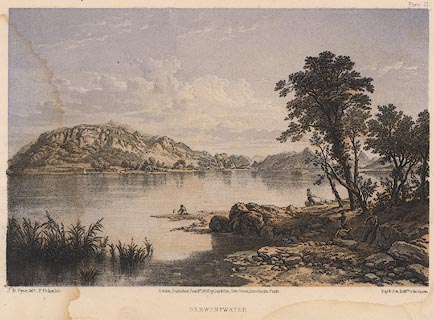 click to enlarge
click to enlargePY21.jpg
"Derwentwater"
item:- JandMN : 97.19
Image © see bottom of page
placename:- Lord's Isle
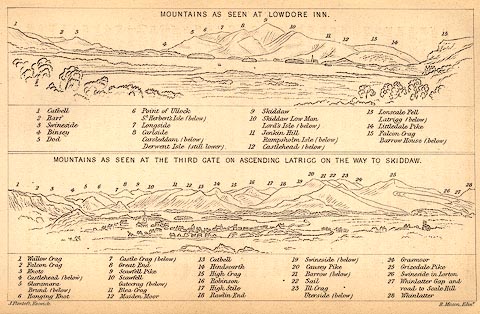 click to enlarge
click to enlargeBC02E4.jpg
"... Lord's Isle ..."
item:- JandMN : 32.7
Image © see bottom of page
placename:- outline view
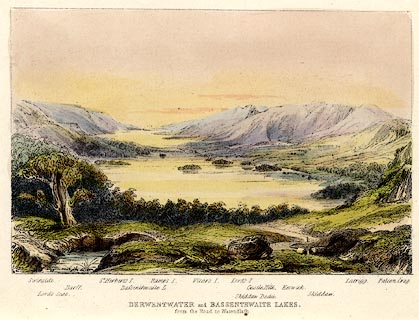 click to enlarge
click to enlargeTAT212.jpg
Included in The Lakes of England, by W F Topham.
printed at bottom:- "DERWENTWATER and BASSENTHWAITE LAKES, / from the road to Watendlath."
printed at bottom:- "Swinside. / Lord's Seat. / Barff. / St. Herbert's I. / Bassenthwaite L. / Ramps I. / Vicar's I. / Lord's I. / Skiddaw Dodd. / Castle Hill. / Keswick. / Skiddaw. / Latrigg. / Falcon Crag."
item:- Armitt Library : A1067.12
Image © see bottom of page
placename:- Lord's Isle
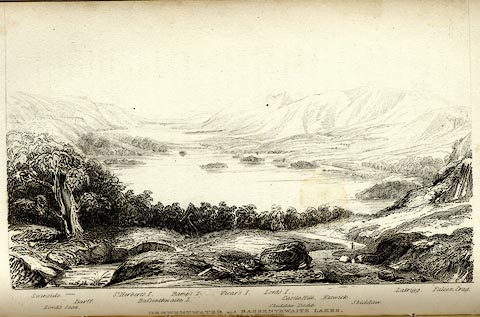 click to enlarge
click to enlargeTAT130.jpg
The print is captioned with mountain names and acts as an outline view.
Tipped in opposite p.77 of The Lakes of England, by George Tattersall.
printed at bottom:- "DERWENTWATER and BASSENTHWAITE LAKES, / from the road to Watendlath."
printed at bottom left to right:- "Swinside. / Lord's Seat. / Barff. / St. Herbert's I. / Bassenthwaite L. / Ramp's I. / Vicar's I. / Lord's I. / Skiddaw Dodd. / Castle Hill. / Keswick. / Skiddaw. / Latrigg. / Falcon Crag."
item:- Armitt Library : A1204.31
Image © see bottom of page
placename:- Lord's Island
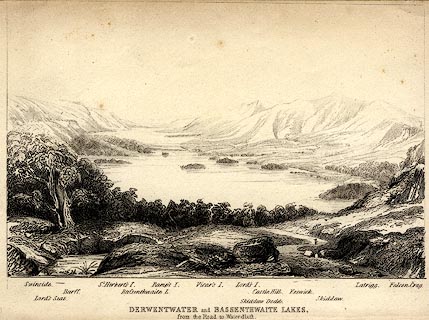 click to enlarge
click to enlargePR0370.jpg
The view is from just above Ashness Bridge. Objects in the view are identified by a caption at the bottom (unfortunately the print is pale, so some objects are unclear, and the caption seems to be a little misaligned) - Swinside, Lord's Seat, Barff, St. Herbert's I., Bassenthwaite L., Ramp's I., Vicar's I., Lord's I., Skiddaw Dodd, Castle Hill, Keswick, Skiddaw, Latrigg, Falcon Crag.
printed at bottom:- "DERWENTWATER and BASSENTHWAITE LAKES. / from the Road to Watendlath."
item:- Dove Cottage : 2008.107.370
Image © see bottom of page
A stranger now must call thee his, which gars my heart to greet
Farewell each friendly well known face, that I have known so well
My tenants now must leave their lands or live their lves in fear."
I wish I'd been sleepin' in my bed last time I mounted thee.
Farewell, farewell, my lady dear, ill, ill thou counsell'd me
No more again I'll see the babe that smiles upon your knee."
Yon sun that rises out the sea shall rise on me no more.
Although that here in London town, I fated am to die,
O, carry me to Northumberland, in my father's tomb to lie."
